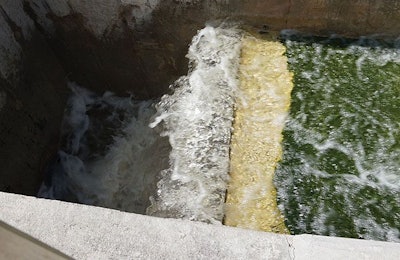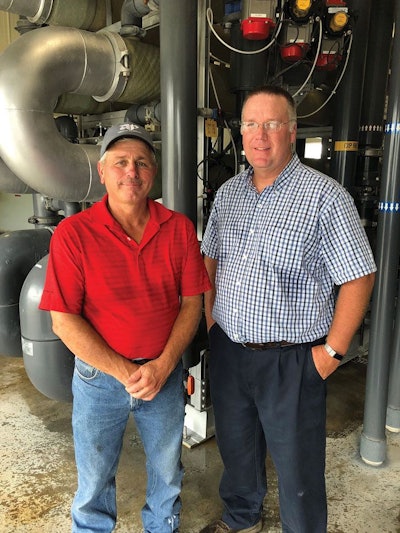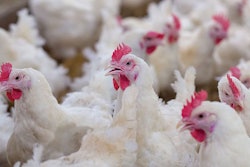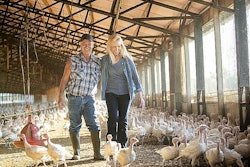
Wayne Farms' Pendergrass, Georgia, facility is seeing proof of concept and payoff from years of discipline and hard work.
The facility, handling wastewater from a poultry processing plant processing about 130,000 large birds per day, is one of the first in the country to use a membrane bioreactor system (MBR) and ultraviolet light (UV) disinfection to treat a daily average of 390,000 million gallons of water. Because of its successful transition to a process not before used in the poultry industry, the facility was selected as the winner of the 2018 U.S. Poultry & Egg Association Clean Water Award for the full treatment category.
The facility is one of nine fresh poultry plants operated by Wayne Farms L.L.C. Wayne is the seventh-largest vertically integrated poultry company in the U.S, according to WATT PoultryUSA’s Top Broiler Company rankings.

Wayne Farms' David Parks, facility wastewater manager, and Jeff Carroll, corporate environmental manager, pose in front of membrane bioreactor ultrafilters. | John Pierson
The MBR transition
The facility, located about an hour away from downtown Atlanta, formerly used a land application system (LAS) to clean pretreated poultry wastewater. However, due to drought and permitting problems, Wayne Farms decided to be the first in the poultry industry to use an MBR and UV system.
The system uses ultrafilters to separate treated water from activated sludge biomass. Enhanced phosphorus precipitation, denitrification and biomass storage occur with reconfigured, existing lagoons on the site. The MBR and UV system, coupled with other upgrades, now yield pathogen-free discharge with overall water quality greater than that produced by the LAS.
Water from the plant is discharged directly into Allen Creek, a tributary to the Middle Oconee River. The MBR and UV system outputs water clean enough to be reused in the plant in non-contact applications.
The staff was challenged with a host of new issues and questions. In the five years since installing the system, the facility committed to steady improvements and learned from their difficulties with the machinery and the new process. For example, the facility used to face trouble with tubular modules used in the MBR. The modules needed to be shipped off-site before they could work again. Rather than deal with this expense and underperformance, the staff found their own solutions to clean the modules and the membranes and keep the machinery running better.

An ultraviolet disinfection system removes viruses from treated water. | John Pierson
Great potential
The Clean Water Awards judging committee considered Wayne Farm’s commitment to the MBR to be significant and deserving of recognition. The facility is pioneering by taking on the risk and the considerable unknowns associated with the new system. Through perseverance, the facility proved that MBR could achieve full treatment for a large-scale poultry processing operation.
The proof-of-concept shows MBR can work in poultry wastewater processing and could potentially be more widely adopted in the future. It also represents a notable advancement in wastewater reuse. The ability to reuse wastewater treated at the plant is important in reducing the overall water use and environmental impact of the operation.
The facility now reuses about 115,000 gallons per day (or 29.9 million gallon a year) of ultra-filtered, reused wastewater for offal screen cleaning and vacuum pump cooling. The leadership team is investigating and studying new applications of the effluent inside the plant. That will take more time and money, but the benefits could be substantial for the operation and the industry as a whole. Perhaps in the future, the treated water could even be used in food contact situations, too.
Peracetic acid handling
Along with the MBR, Wayne Farms Pendergrass is notable for its strategy of handling wastewater containing peracetic acid (PAA). As consumers reject the use of chlorine in chicken processing, PAA is used in chillers as a disinfectant. However, PAA is hard on wastewater processing equipment and couldn’t be handled when the chiller was drained.
To solve this problem, the wastewater team decided to store the PAA water from the chiller in a tank and then slowly bleed it into the water being treated throughout the course of the day. This mitigated the impact of the PAA and allowed the staff to maintain a constant level of PAA in the partially treated water.


















